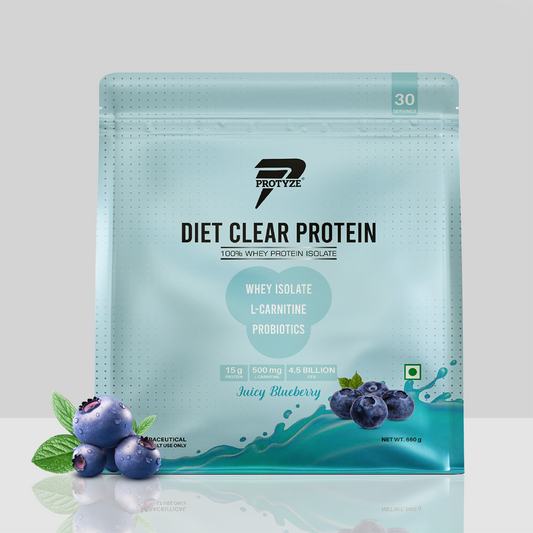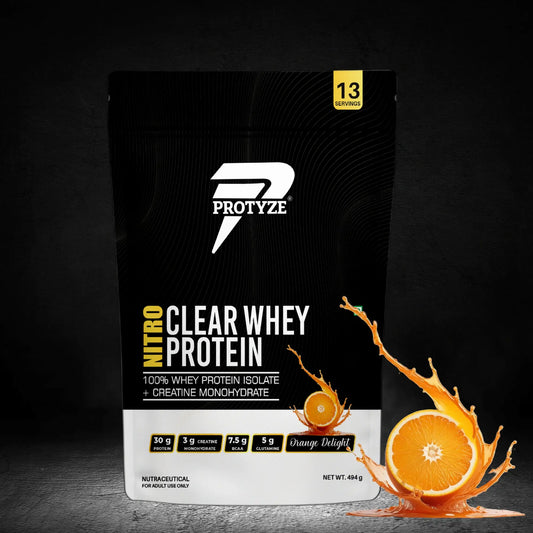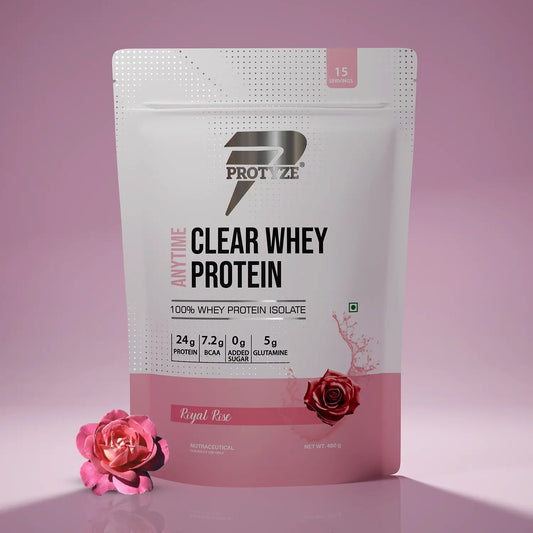Whey protein has become a cornerstone of fitness nutrition, trusted by athletes, gym-goers, and health enthusiasts to support muscle growth, recovery, and overall wellness. However, with its rising popularity comes a growing challenge: the proliferation of fake or counterfeit whey protein products.
These imitations not only fail to deliver the promised benefits but can also pose health risks due to substandard ingredients, contaminants, or misleading nutritional claims. For anyone investing in their fitness, distinguishing genuine whey protein from fakes is essential.
This blog explores the dangers of counterfeit products, key indicators to spot them, practical steps for verification, and tips for safe purchasing. We’ll also highlight Protyze Diet Clear Whey Protein, a high-purity option with flavors like Juicy Blueberry, as an example of a quality product to consider.
The Risks of Fake Whey Protein
Purchasing fake whey protein can have serious consequences, both for your health and your fitness goals:
- Health Hazards: Counterfeit products may contain harmful additives, such as unlisted sugars, artificial fillers, or even industrial chemicals, leading to digestive issues, allergic reactions, or long-term toxicity.
- Nutritional Deficiency: Fakes often lack the protein content advertised, leaving you short of the amino acids needed for muscle repair and growth, undermining your training efforts.
- Financial Loss: Spending money on ineffective or diluted products wastes resources, especially when premium whey protein comes at a higher cost for a reason.
- Erosion of Trust: Repeated experiences with fakes can discourage users from supplementing, even with legitimate brands, stalling their fitness progress.
- Legal and Ethical Concerns: Supporting counterfeit markets can perpetuate illegal practices, harming reputable companies and consumers alike.
Understanding these risks underscores the importance of vigilance when selecting a whey protein product, ensuring you get the quality you deserve.
Why Fake Whey Protein Is a Growing Problem
The whey protein market’s expansion has attracted opportunists looking to profit from low-quality imitations. Several factors contribute to this issue:
- High Demand: The global surge in fitness awareness has increased demand, creating a lucrative opportunity for counterfeiters to flood the market with cheap alternatives.
- Complex Supply Chains: Products often pass through multiple distributors, making it easier for fakes to enter the stream undetected.
- Price Competition: Lower-priced knockoffs appeal to budget-conscious buyers, masking their inferior quality until after purchase.
- Lack of Awareness: Many consumers, especially newcomers to fitness, may not know how to verify authenticity, leaving them vulnerable to deception.
- Online Marketplace Risks: E-commerce platforms, while convenient, can harbor unverified sellers offering counterfeit goods under the guise of legitimate brands.
This environment makes it critical for buyers to arm themselves with knowledge to avoid falling prey to these pitfalls.
How to Spot a Fake Whey Protein
Identifying a counterfeit whey protein requires attention to detail across packaging, product characteristics, and purchasing practices. Here are the key indicators:
1. Check Packaging Quality
- Signs of Fakes: Poor print quality, misspelled words, blurry logos, or inconsistent branding (e.g., uneven colors or fonts) often signal a counterfeit. Genuine products, like those from reputable brands, feature crisp, professional packaging.
- What to Look For: Holograms, batch numbers, and tamper-evident seals are common on authentic items. Compare the packaging to official images on the brand’s website.
2. Examine Nutritional Information
- Signs of Fakes: Unrealistic claims, such as excessively high protein content (e.g., 50g per serving with minimal calories) or missing amino acid profiles, suggest dilution or falsification.
- What to Look For: A balanced label with 15-30g of protein per serving, minimal fats and carbs (especially in isolates), and a clear ingredient list. For eg, Protyze Diet Clear Whey Protein lists 15g protein with ~60 kcal, reflecting its purity.
3. Assess Texture and Solubility
- Signs of Fakes: Clumpy, gritty, or oily textures, or poor mixing with water or milk, indicate low-quality processing or added fillers. Genuine whey, especially clear varieties, should dissolve smoothly.
- What to Look For: A light, clear consistency when mixed, as seen with Protyze Diet Clear Whey Protein (Juicy Mango flavor), which blends effortlessly with water.
4. Evaluate Taste and Aftertaste
- Signs of Fakes: Artificial, overly sweet, or bitter aftertastes often result from cheap sweeteners or contaminants. Authentic whey offers a balanced, pleasant flavor.
- What to Look For: Natural fruit flavors like Juicy Litchi in Protyze Diet Clear Whey Protein, with no lingering unpleasantness, indicate quality ingredients.
5. Verify Source and Authenticity
- Signs of Fakes: Unbranded or suspiciously low-priced products from unknown sellers, especially online, are red flags.
- What to Look For: Purchase from authorized retailers or the brand’s official website. Check for QR codes or serial numbers that can be validated, a practice some brands use to ensure authenticity.
6. Test Product Effectiveness
- Signs of Fakes: Lack of muscle recovery, persistent fatigue, or no strength gains after consistent use may indicate insufficient protein or poor quality.
- What to Look For: Noticeable improvements in recovery and performance, as experienced with high-purity options like Protyze Diet Clear Whey Protein, which supports lean muscle maintenance.
7. Smell and Color
- Signs of Fakes: Unusual odors (e.g., chemical or rancid smells) or unnatural colors (e.g., overly vibrant hues) suggest synthetic additives or spoilage.
- What to Look For: A mild, fruity scent and a clear, natural tint, consistent with the quality of reputable clear whey products.
These indicators empower buyers to scrutinize products and avoid counterfeit traps.
Practical Steps to Verify Whey Protein
Beyond visual checks, proactive steps can confirm a product’s legitimacy:
- Buy from Trusted Sources: Stick to official brand websites, authorized distributors, or well-known fitness stores to minimize risk.
- Check Certifications: Look for seals from organizations like ISO, GMP, or FSSAI (if applicable), which indicate adherence to quality standards.
- Contact the Brand: Reach out to customer service with batch numbers or questions; genuine companies provide responsive support.
- Use Lab Testing: For peace of mind, send a sample to a third-party lab to verify protein content and purity, though this is more common for bulk purchases.
- Join Fitness Communities: Engage with online forums or local gym groups to share experiences and identify trustworthy products.
These measures add layers of assurance, protecting your investment and health.
How to Safely Purchase Whey Protein
Navigating the market requires a strategic approach to avoid fakes:
- Research Brands: Choose companies with a strong reputation, transparent ingredient sourcing, and positive user feedback.
- Compare Prices: Be wary of deals significantly below market rates; quality whey protein reflects its cost.
- Read Reviews: Look for detailed, unbiased reviews from verified buyers to gauge product authenticity.
- Check Expiry and Batch Details: Ensure packaging includes clear manufacturing and expiry dates, and avoid products with damaged or missing labels.
- Avoid Unverified Sellers: Steer clear of unbranded marketplaces or sellers with no return policy, opting instead for secure, traceable purchases.
- Sample First: If possible, try a small tub before committing to a larger quantity to assess quality and effectiveness.
Following these guidelines helps ensure you bring home a genuine product.
The Role of Protyze Diet Clear Whey Protein
For those seeking a reliable whey protein, Protyze Diet Clear Whey Protein exemplifies the qualities of an authentic product. With 15g of protein per serving and a low-calorie profile (~60 kcal), it uses a high-purity whey isolate base, enhanced with probiotics for digestive health. Its 99% lactose-free formula, mixed with water, delivers a light, refreshing experience in flavors like Juicy Blueberry, free from the bloating or grittiness often found in fakes. This product’s transparency in labeling and smooth solubility make it a benchmark for quality, reassuring buyers of its legitimacy.
Benefits of Choosing Authentic Whey Protein
Investing in genuine whey protein, like Protyze Diet Clear Whey Protein (Juicy Litchi flavor), offers clear advantages:
- Effective Muscle Support: Delivers the amino acids needed for growth and repair, supporting your fitness goals.
- Health Safety: Avoids contaminants, ensuring no adverse effects on your well-being.
- Value for Money: Provides measurable results, justifying the cost over cheap imitations.
- Consistency: Reliable quality builds trust, encouraging long-term use in your routine.
These benefits highlight why authenticity matters in your supplement choice.
How to Incorporate Authentic Whey Protein into Your Routine
Once you’ve secured a genuine product, integrate it effectively:
- Timing: Use Protyze Diet Clear Whey Protein post-workout with 200-300ml of water to aid recovery, or as a snack to meet daily protein needs (1.2-2.0g/kg body weight).
- Dosage: A single scoop (15g protein) daily, adjustable based on activity level and goals.
- Pairing: Combine with a balanced diet—lean meats, vegetables, and whole grains—to maximize nutrition.
- Hydration: Drink 2-3L of water daily to support protein metabolism and overall health.
Sample Day (70kg Person, General Fitness):
- Morning: Oatmeal with fruit, 2 eggs, water.
- Mid-Morning: Protyze Diet Clear Whey Protein (Juicy Mango flavor) with water, nuts.
- Lunch: Grilled chicken, brown rice, spinach, water.
- Afternoon: 45-min workout, protein-rich snack.
- Dinner: Fish, quinoa, broccoli, water.
- Evening: Stretching, 7-9 hours sleep.
This approach ensures you leverage the benefits of authentic whey protein.
Conclusion
Spotting a fake whey protein is a skill every fitness enthusiast should master to protect their health, wallet, and progress. By examining packaging, nutritional details, texture, taste, and purchase sources, you can confidently identify genuine products and avoid the pitfalls of counterfeits. Choosing a high-quality option like Protyze Diet Clear Whey Protein, with its 15g protein, ~60 kcal, probiotic support, and 99% lactose-free formula in flavors like Juicy Blueberry, offers peace of mind and effective results. Arm yourself with knowledge, shop smart, and invest in your fitness with a product you can trust, ensuring every scoop brings you closer to your goals in 2025.





